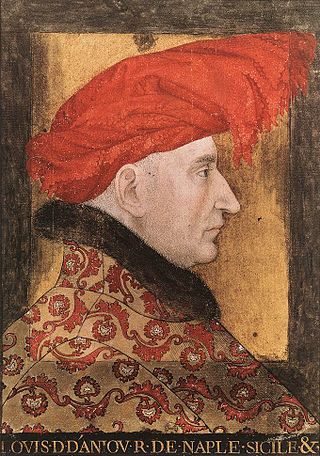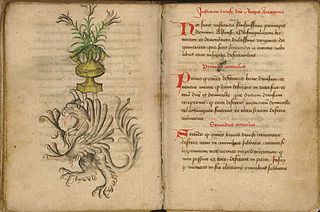External links
![]() Media related to Ordre du Navire at Wikimedia Commons
Media related to Ordre du Navire at Wikimedia Commons
The Order of the Ship (French Ordre de la Nef) was a secular order of knighthood in the Kingdom of Naples founded and dedicated to the Holy Trinity by King Charles III of the House of Durazzo on 1 December 1381 and no longer active by 1386.
Charles III was crowned King of Naples in the Castel Nuovo in Naples on 25 November. During the festivities that followed, he inducted seven or eight knights into a new order of his own creation at a ceremony in the great chapel of the Castel Nuovo on 1 December. In this he was probably imitating the founding of the Order of the Knot by King Louis I twenty years earlier on 25 May 1352, the same day as his coronation. Although there were present in Naples men who would have remembered the founding of the Order of the Knot, but it is unlikely that Charles sought to revive the Order of the Knot, defunct since Louis's death in 1362, since Louis's heirs were Charles's rivals for the throne. [1]
The only contemporary evidence for the structure and history of the order are two copies of its statutes, both composed in Middle French. The original master copy of the statutes, the Livre de estatus et chapistrez, which was also in French and was to be kept in the order's chapel, is lost. It was probably richly illustrated in imitation of that of the Order of the Knot. The statutes themselves are modelled on those of the Order of the Knot and the Hungarian Order of Saint George, of which Charles was a member. [1] The two manuscripts are MS French 83 in the Van Pelt Library of the University of Pennsylvania and MS L III 29 of the Biblioteca nazionale universitaria in Turin. [2] According to the Pennsylvania manuscript, the order had eight original members (Charles and seven others), while the Turin manuscript lists eight knights besides Charles. [3] Eight other men are recorded elsewhere as having been members of the order at some point, based largely on sepulchral inscriptions. [1]
It is unlikely that the Order of the Ship was very active, since Charles III not only had to fight wars to keep his Neapolitan throne, but also laid claim to the Hungarian throne in 1382. He was assassinated in Hungary on 24 February 1386, leaving a child, Ladislaus, as his heir under the regency of his widow, Margaret. The Order of the Ship, if it was still active in any sense, died with Charles. During her regency, Margaret instituted a new order (compagnia) the device of which was a gold-embroidered spindle or capstan (argata) on a red field. There is no evidence that Ladislaus continued either his father's or his mother's order. [1] [4]
The first historian to write about the Order of the Ship was Pandolfo Collenuccio in his Compendio dell'Istoria del Regno di Napoli, first published at Venice in 1539 and printed again in 1541, 1552 and 1613. He believed that the ship after which the order was named was the Argo of Greek legend. José Micheli y Márquez, in his Tesoro militar de cavallería, published at Madrid in 1642, embellished Collenuccio's connection. He stated that the order was dedicated to Saint Nicholas of Myra and was known as the Order of the Argonauts of Saint Nicholas, adding that these medieval Argonauts, wearing the white habit, gathered annually on Saint Nicholas' Day (6 December) for a feast in the cathedral of Bari, which was dedicated to Nicholas. Micheli y Márquez is the main source for most of the false information that has spread about the order. [5] The actual habit of the order, according to its statutes, was red and green. [6]
The original companions of the order as listed in MS French 83, with Italian names in brackets: [3]
Additional companions named by MS L III 29:
Each member bore the title Monsire (French 83) or Messire (L III 29). [3]
![]() Media related to Ordre du Navire at Wikimedia Commons
Media related to Ordre du Navire at Wikimedia Commons

Alfonso the Magnanimous was King of Aragon and King of Sicily and the ruler of the Crown of Aragon from 1416 and King of Naples from 1442 until his death. He was involved with struggles to the throne of the Kingdom of Naples with Louis III of Anjou, Joanna II of Naples and their supporters, but ultimately failed and lost Naples in 1424. He recaptured it in 1442 and was crowned king of Naples. He had good relations with his vassal, Stjepan Kosača, and his ally, Skanderbeg, providing assistance in their struggles in the Balkans. He led diplomatic contacts with the Ethiopian Empire and was a prominent political figure of the early Renaissance, being a supporter of literature as well as commissioning several constructions for the Castel Nuovo.

Charles III was King of Spain in the years 1759 to 1788. He was also Duke of Parma and Piacenza, as Charles I (1731–1735); King of Naples, as Charles VII; and King of Sicily, as Charles III (1735–1759). He was the fourth son of Philip V of Spain and the eldest son of Philip's second wife, Elisabeth Farnese. He was a proponent of enlightened absolutism and regalism.
Charles of Durazzo, also called Charles the Small, was King of Naples and the titular King of Jerusalem from 1382 to 1386 as Charles III, and King of Hungary from 1385 to 1386 as Charles II. In 1381, Charles created the chivalric Order of the Ship. In 1383, he succeeded to the Principality of Achaea on the death of James of Baux.

The Order of the Dragon was a monarchical chivalric order only for selected higher aristocracy and monarchs, founded in 1408 by Sigismund of Luxembourg, who was then King of Hungary and Croatia and later became Holy Roman Emperor. It was fashioned after the military orders of the Crusades, requiring its initiates to defend the cross and fight the enemies of Christianity, particularly the Ottoman Empire.

Ladislaus the Magnanimous was King of Naples from 1386 until his death and an unsuccessful claimant to the kingdoms of Hungary and Croatia. Ladislaus was a skilled political and military leader, protector and controller of Pope Innocent VII; however, he earned a bad reputation concerning his personal life. He profited from disorder throughout Italy to greatly expand his kingdom and his power, appropriating much of the Papal States to his own use. He was the last male of the Capetian House of Anjou.

Charles Martel of the Capetian dynasty was the eldest son of king Charles II of Naples and Mary of Hungary, the daughter of King Stephen V of Hungary. The 18-year-old Charles Martel was set up by Pope Nicholas IV and the ecclesiastical party as the titular King of Hungary (1290–1295) as the successor of his maternal uncle, the childless Ladislaus IV of Hungary against whom the Pope had already earlier declared a crusade.

Louis II was Duke of Anjou and Count of Provence from 1384 to 1417; he claimed the Kingdom of Naples, but only ruled parts of the kingdom from 1390 to 1399. His father, Louis I of Anjou—the founder of the House of Valois-Anjou—was a younger son of King John II of France and the adopted son of Queen Joanna I of Naples. When his father died during a military campaign in Naples in 1384, Louis II was still a child. He inherited Anjou from his father, but his mother, Marie of Blois, could not convince his uncles, John, Duke of Berry and Philip II, Duke of Burgundy, to continue her husband's war for Naples. The Provençal nobles and towns refused to acknowledge Louis II as their lawful ruler, but Marie of Blois persuaded them one after another to swear fealty to him between 1385 and 1387.

Joanna II was reigning Queen of Naples from 1414 to her death, when the Capetian House of Anjou became extinct. As a mere formality, she used the title of Queen of Jerusalem, Sicily, and Hungary.

Frederick, sometimes called Frederick IV or Frederick of Aragon, was the last king of Naples from the Neapolitan branch of the House of Trastámara, ruling from 1496 to 1501. He was the second son of Ferdinand I, younger brother of Alfonso II, and uncle of Ferdinand II, his predecessor.

Louis of Enghien titular Duke of Athens, Count of Brienne and Lord of Enghien in 1381–1394, Count of Conversano in 1356–1394.
Raimondo Orsini del Balzo was a nobleman from the Kingdom of Naples. He was Count of Soleto (1382), Prince of Taranto (1399–1406), Duke of Bari, Grand Constable of the Kingdom of Naples, Gonfalonier of the Holy Roman Church. He was a member of the influential Orsini family of Rome. Although he is considered one of the most important people in the history of southern Italy, relatively little is known about his life.

An order of chivalry, order of knighthood, chivalric order, or equestrian order is an order of knights, typically founded during or inspired by the original Catholic military orders of the Crusades and paired with medieval concepts of ideals of chivalry.

D'Arcy Jonathan Dacre Boulton is a Canadian medieval historian, and heraldic author and artist.

Alberico da Barbiano was the first of the Italian condottieri. His master in military matters was the English mercenary John Hawkwood, known in Italy as Giovanni Acuto. Alberico's compagnia fought under the banner of Saint George, as the compagnia San Giorgio.

The Princes of Canino and Musignano formed the genealogically senior line of the Bonaparte family following the death of Joseph Bonaparte in 1844. The line was succeeded by one of Emperor Napoleon's younger brothers, Lucien Bonaparte. It became extinct in the male line in 1924. The dynastic Bonapartist pretenders descend in the male line from Prince Jérôme Napoléon, Napoleon's youngest brother.

Castel Nuovo, often called Maschio Angioino, is a medieval castle located in front of Piazza Municipio and the city hall in central Naples, Campania, Italy. Its scenic location and imposing size makes the castle, first erected in 1279, one of the main architectural landmarks of the city. It was a royal seat for kings of Naples, Aragon and Spain until 1815.
Margaret of Durazzo was Queen of Naples and Hungary and Princess of Achaea as the spouse of Charles III of Naples. She was regent of Naples from 1386 until 1393 during the minority of her son Ladislaus of Naples.

The Capetian House of Anjou, or House of Anjou-Sicily, was a royal house and cadet branch of the direct French House of Capet, part of the Capetian dynasty. It is one of three separate royal houses referred to as Angevin, meaning "from Anjou" in France. Founded by Charles I of Anjou, the youngest son of Louis VIII of France, the Capetian king first ruled the Kingdom of Sicily during the 13th century. The War of the Sicilian Vespers later forced him out of the island of Sicily, which left him with the southern half of the Italian Peninsula, the Kingdom of Naples. The house and its various branches would go on to influence much of the history of Southern and Central Europe during the Middle Ages until it became extinct in 1435.

The Order of the Jar was a chivalric order founded by Ferdinand of Antequera in 1403. After Ferdinand became King of Aragon in 1412, it became a royal order and lasted until 1516.
Palamede Bozzuto was an Italian knight and nobleman who took part in the wars of the succession of the Kingdom of Naples between the Angevins and the Durazzo. He was a partisan of the latter. In the Western Schism, he was a fierce supporter of Pope Urban VI.